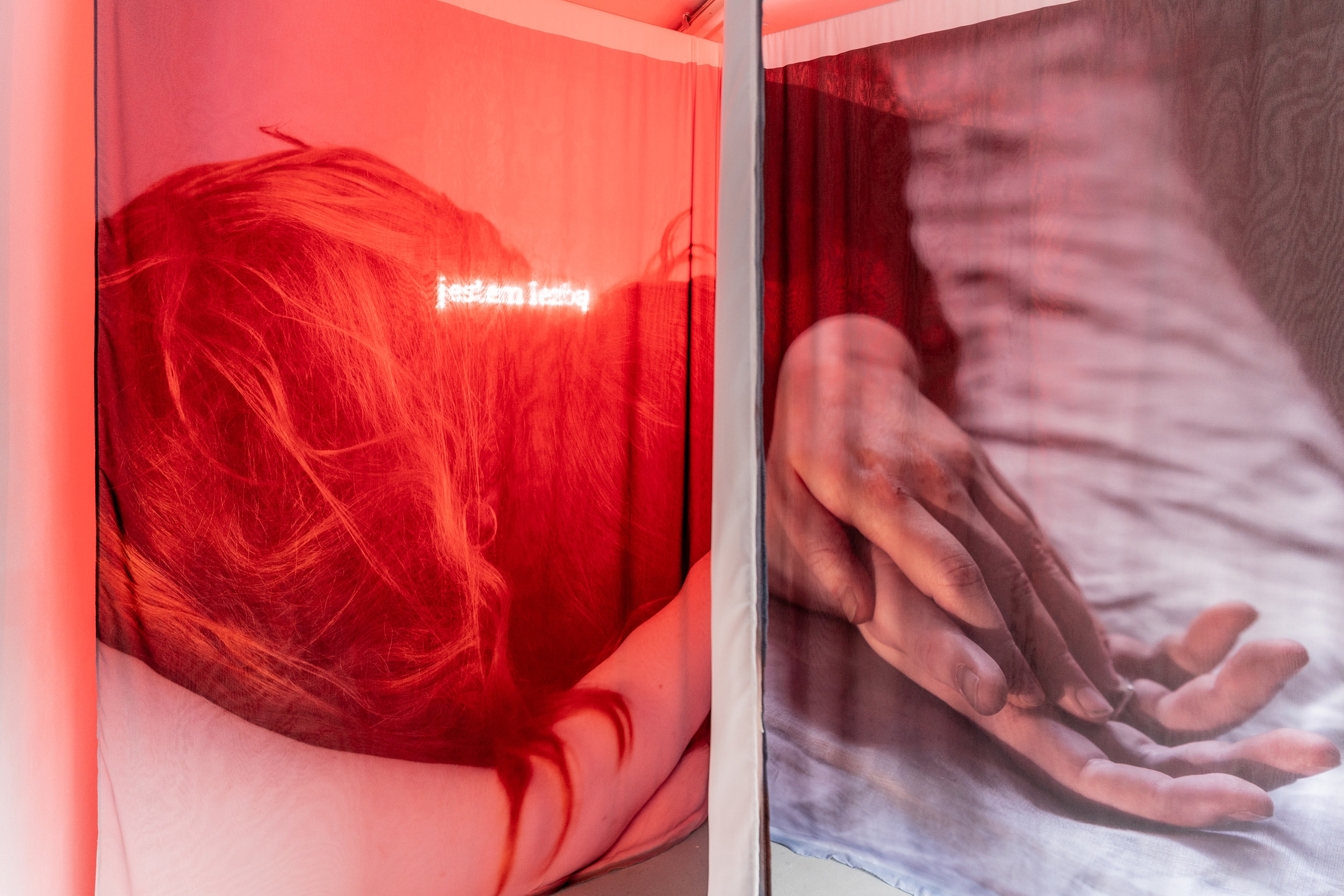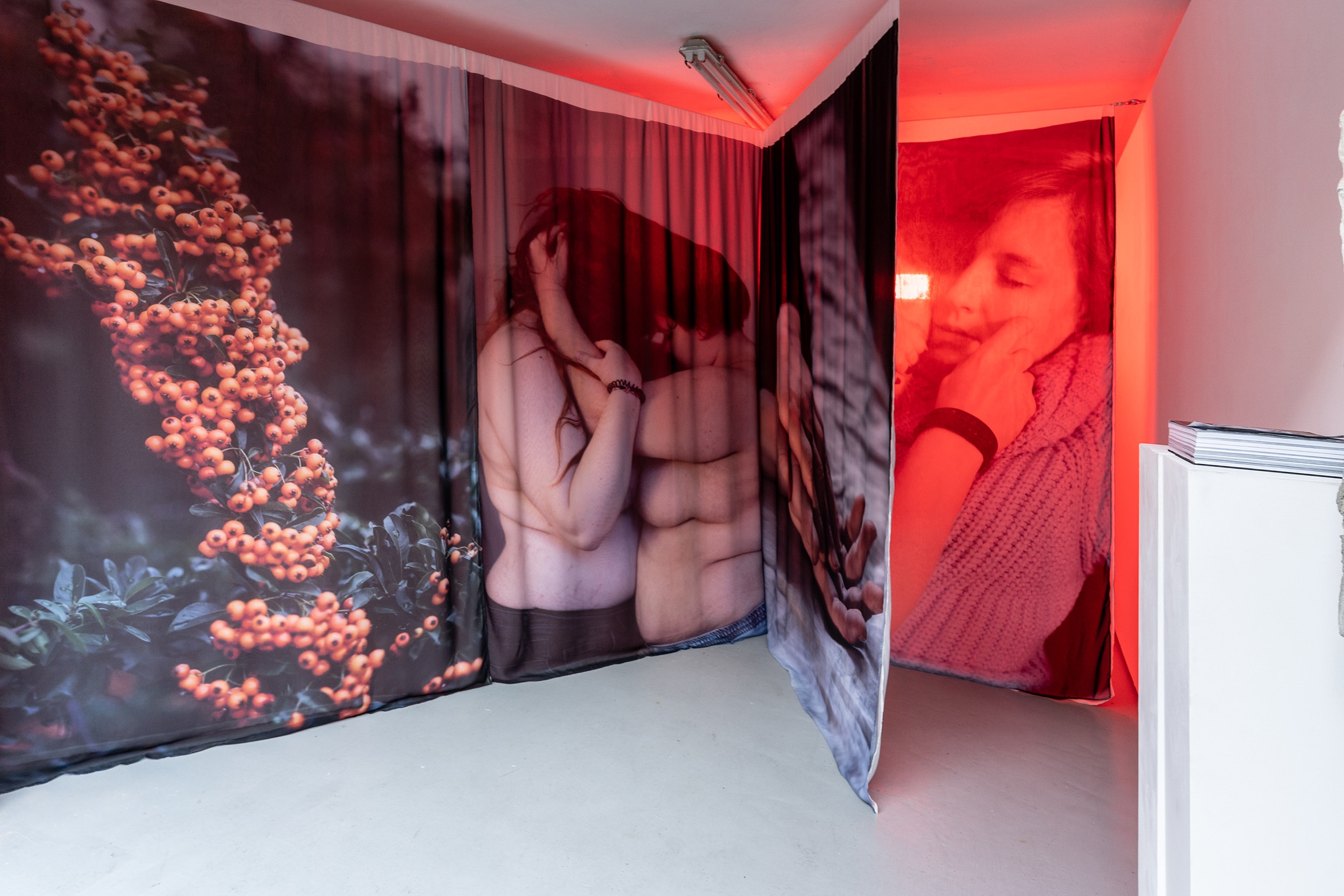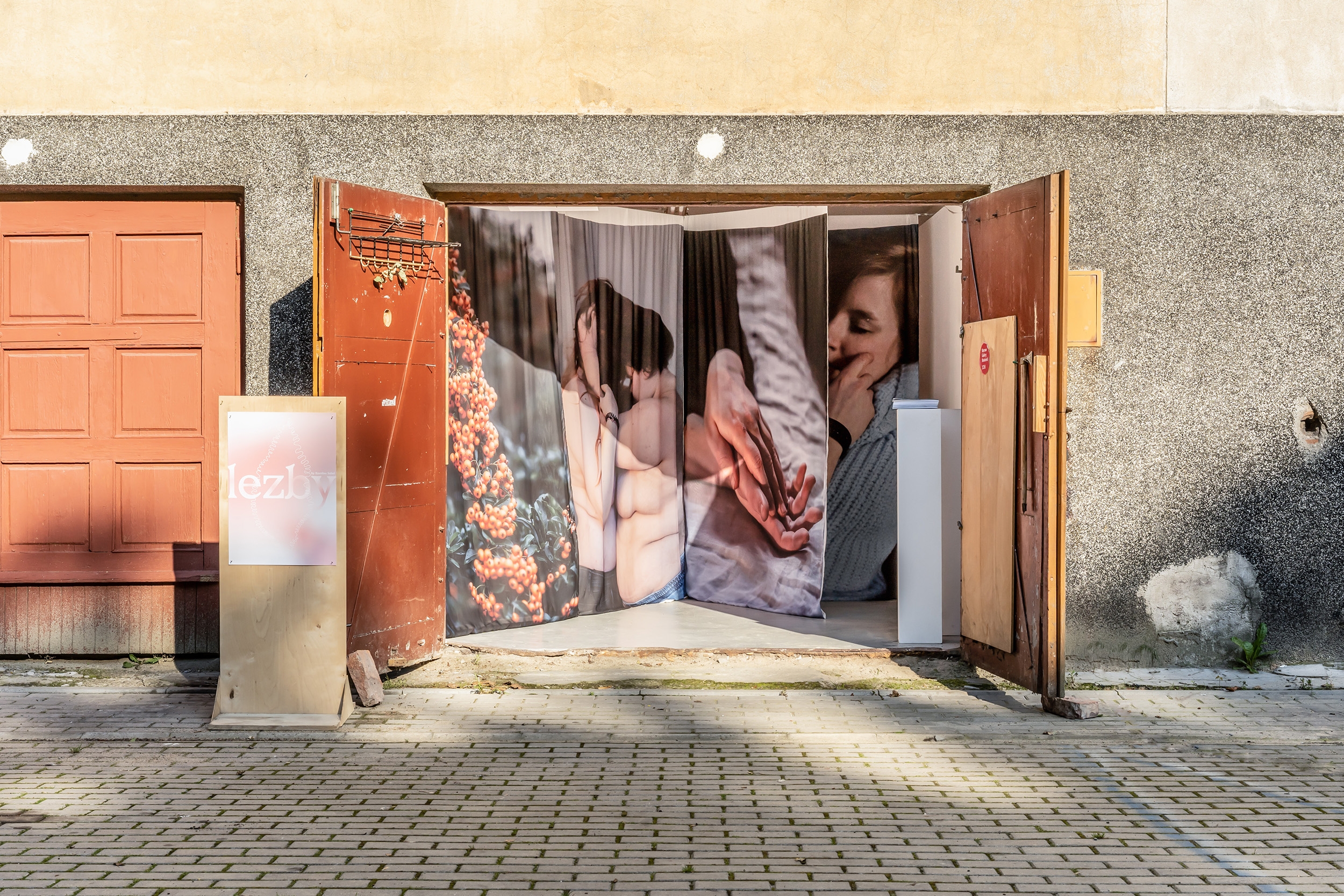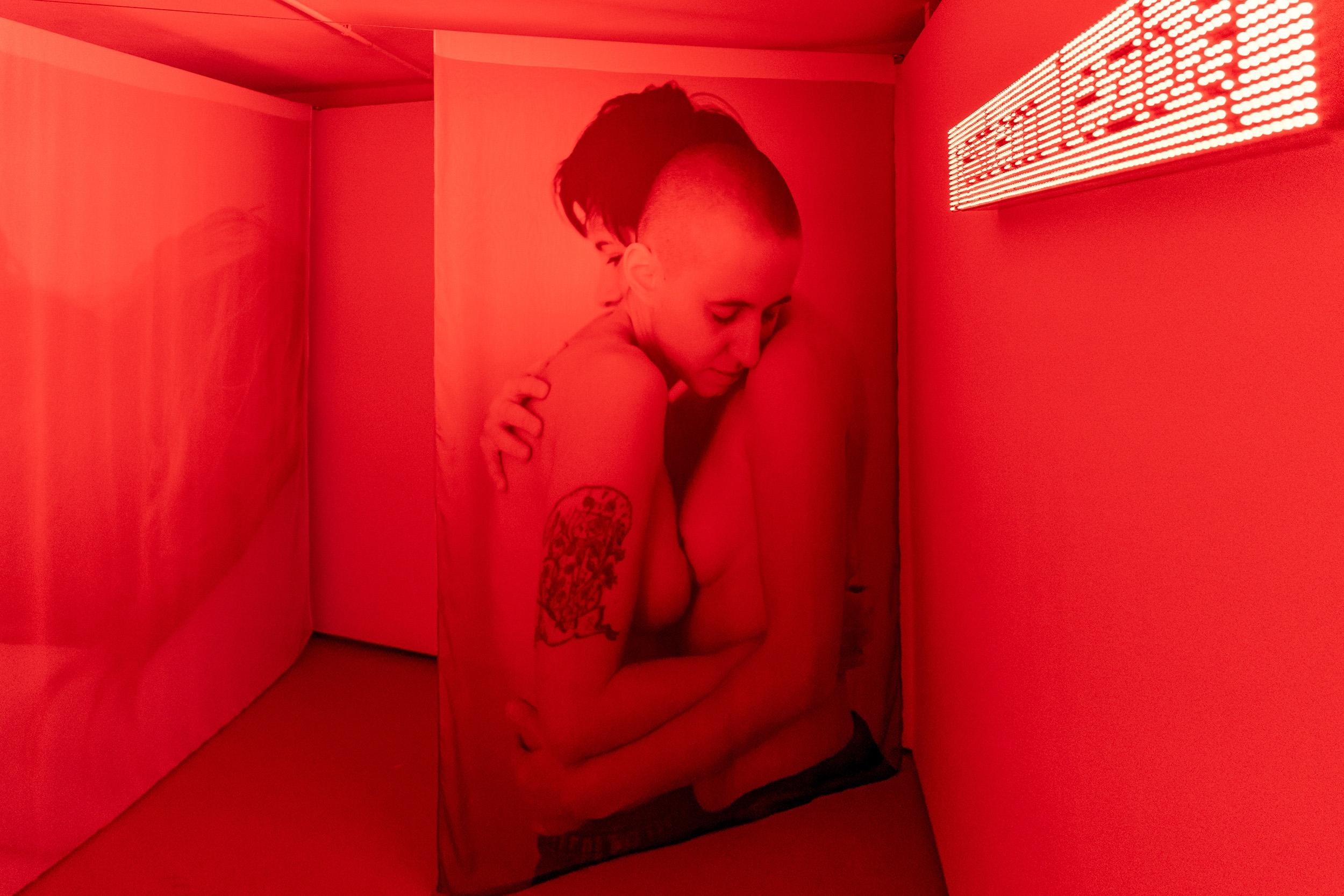![[EN/PL] ‘LEZBY’ by Karolina Sobel at Stroboskop Art Space](https://blokmagazine.com/wp-content/uploads/2020/07/20200620-lezby--005.jpg)
[EN]
An exploration of female subjectivity and agency, this installation consists of large-scale photographs printed on soft, transparent fabrics that revolve around the notion of care. It is care for both the other and for the self that Sobel is interested in, as a vulnerable and fragile, often times invisible gesture. It provokes feelings of intimacy, closeness and communication with others. Care embodies the essence of personal disclosure, the will to show oneself voluntarily to their beloved. Care provides a sacred space where we can be ourselves. Care is that element of love, next to passion and commitment, which articulates dimensions of respect, comprehension, and sympathy. Care is often expressed through displays of affection such as physical touch, and can be a barometer for relationships. It is the moments of care in the everyday that slowly and deeply weave social change.
LEZBY is inspired by Polish artist Karol Radziszewski’s 2005 exhibition Pedały, which dealt with themes of male homosexuality, censorship, risk, and desire in both mainstream and sub-cultures. The term lezby (lesbians), carries a certain stigma, it is used as a pejorative, people are not used to it. Reclaiming this word like this, as Judith Butler points out, is an act of empowerment and provocation. Sobel now asks whether 15 years is long enough to establish a queer history in Poland. What has changed in this time and where are all the women!? Queer/homosexual history is not only a male history. What do lesbians want? How do lesbians negotiate their identities? How is lesbian identity negotiated in contemporary culture?
Sobel collects found images of public figures who identify either as lesbian or bisexual, or who are sympathizers and supporters of the LGBTQI+ community, or perhaps are rumored in tabloids to be non-hetero. These works are presented as a wall calendar.
Using images from magazine covers or other publicly-accessibly realms like online search engines, etc., Sobel categorizes them: woman with weapon, woman in suits, femme, woman with cigarette, butch, diva, french woman, tomboy, sportswoman, woman in couple, face of the woman. Referring to Borges ‘Chinese Encyclopedia‘, Sobel mocks the sheer creation of categories as archetypes for lesbians in mainstream and sub-culture. Sobel’s suggested archetypes affirm the queer gaze, which has now been directed towards the female body and its representation in contemporary visual culture.
Through LEZBY, Sobel aims to create space for a multitude of voices and so has invited several artists to collaborate on various aspects of the project. Performer and choreographer Marta Ziółek will stage a happening at the opening where she will interpret the presented works. She will refer to the aforementioned archetypes through movement and gesture, transforming visual stereotypes into their fuller physicality of fluid, dimensional movement, providing yet another opportunity to re-examine and re-contextualize these agreed-upon standards. Through the performative body these categories loose their sharp edges and begin to fluently morph from one into another. Musician Kamil Pater will create the soundscape for the performance. Later in the week, artist Liliana Piskorska will conduct a workshop `Feminist-queer practices of political sensitivity‘ which will be open to the public. There will be limited spaces so reservations will be necessary. To close the exhibition, Sobel has invited Kerstin Möller to present her sound installation „Precarious Bodies“ and to perform her concert Kersley Care & The City. The latter is an experimental music project that works with found sounds, piano sounds, vocal loops and soft beats, often drawing on the sounds of cities, infrastructure blues and the deep-felt sensations of care.
[PL]
Instalacja jest eksploracją kobiecej podmiotowości i sprawczości, obracającą się wokół pojęcia troski. Praca składa się z wielkoformatowych fotografii drukowanych na miękkich, przezroczystych tkaninach. W centrum zainteresowania Sobel jest troska zarówno o siebie, jak i o drugiego człowieka, postrzegana jako wrażliwy i delikatny, często niewidoczny gest. Troska odwołuje się do intymności, bliskości i komunikacji z drugim człowiekiem. Jest odsłonięciem siebie, dobrowolnym ukazaniem siebie ukochanej osobie. Troska stwarza przestrzeń, w której możemy być sobą. Jest tym elementem miłości, obok pasji i zaangażowania, który pozwala wyrazić szacunek, zrozumienie i współczucie. Jest ona często manifestacją uczuć, okazywanych, np. przez dotyk fizyczny, i może być barometrem relacji. To właśnie codzienne okazywanie sobie troski powoli i głęboko przyczynia się do przemian społecznych.
Inspiracją dla LEZB jest wystawa polskiego artysty Karola Radziszewskiego Pedały z 2005 roku, która podejmowała tematy męskiego homoseksualizmu, cenzury, ryzyka i pożądania zarówno w mainstreamie, jak i w subkulturach. Termin lezby (lesbijki) stygmatyzuje, jest nacechowany pejoratywnie. Odzyskanie tego słowa w ten sposób, jak wskazuje Judith Butler, jest aktem upodmiotowienia i prowokacji. Sobel poprzez swoją wystawę pyta, czy przez 15 lat udało się stworzyć w Polsce historię queer. Co się zmieniło w tym czasie i gdzie są te wszystkie kobiety!? Historia queer nie jest tylko historią pisaną z perspektywy gejowskiej. Czego chcą lesbijki? Jak lesbijki negocjują swoją tożsamość? W jaki sposób negocjuje się tożsamość lesbijską we współczesnej kulturze?
Sobel zbiera wizerunki osób publicznych, które identyfikują się jako lesbijki, biseksualistki bądź sympatyczki i zwolenniczki społeczności LGBTQI+, lub wizerunki kobiet, o których krążą plotki w brukowej prasie, że nie są heteroseksualne. Praca ta jest prezentowana w formie kalendarza ściennego. Sobel używa zdjęć z okładek czasopism lub innych publicznie dostępnych witryn, kategoryzując je na: kobiety z bronią, kobiety w garniturach, femme, kobiety z papierosem, butch, diva, francuskie kobiety, tomboy, sportsmenki, kobiety w parze oraz twarz kobiety. Nawiązując do Borgesowskiej ‘Chińskiej Encyklopedii’, Sobel kpi z samego tworzenia kategorii jako archetypów dla lesbijek w mainstreamie i subkulturze. Sugerowane przez Sobel archetypy mają na celu afirmację queerowego spojrzenia, które w tym przypadku ukierunkowane jest na kobiece ciało i jego reprezentację we współczesnej kulturze wizualnej.
Poprzez LEZBY Sobel dąży do stworzenia wielogłosu, dlatego też zaprosiła kilka artystek i artystę do współpracy nad różnymi aspektami projektu. Performerka i choreografka Marta Ziółek zaprezentuje na wernisażu happening, w którym zinterpretuje eksponowane prace. Ziółek odniesie się do zaproponowanych archetypów poprzez ruch i gest, przekształcając wizualne stereotypy w fizyczność płynnego ruchu, dając jeszcze jedną szansę na ich ponowne zbadanie i skontekstualizowanie. Poprzez performatywne ciało kategorie te tracą swoje ostre krawędzie i zaczynają płynnie przechodzić jedne w drugie. Muzyk Kamil Pater stworzy pejzaż dźwiękowy dla spektaklu. Kolejnym wydarzeniem będzie otwarty dla publiczności warsztat Feministyczno – queerowe praktyki politycznej wrażliwości artystki Liliany Piskorskiej. Z uwagi na ograniczoną ilość miejsc konieczna będzie rezerwacja. Na zakończenie wystawy Sobel zaprosi Kerstin Möller do zaprezentowania instalacji dźwiękowej Precarious Bodies oraz do zagrania koncertu Kersley Care & The City. Ten ostatni to eksperymentalny projekt muzyczny, w którym artystka pracuje ze znalezionymi dźwiękami, pętlami wokalnymi i miękkimi bitami, często czerpiąc z brzmień miast, infrastrukturalnego bluesa i głęboko odczuwalnych doznań troski. Wydarzenia zamykające finansuje Biuro Kultury Miasta Hanower.
Imprint
| Artist | Karolina Sobel |
| Exhibition | LEZBY |
| Place / venue | Stroboskop Art Space, Warsaw |
| Dates | 20 June – 11 July 2020 |
| Photos | Karolina Sobel |
| Website | stroboskop-space.pl |
| Index | Kamil Pater Karolina Sobel Kersley Liliana Piskorska Marta Ziółek Stroboskop |




